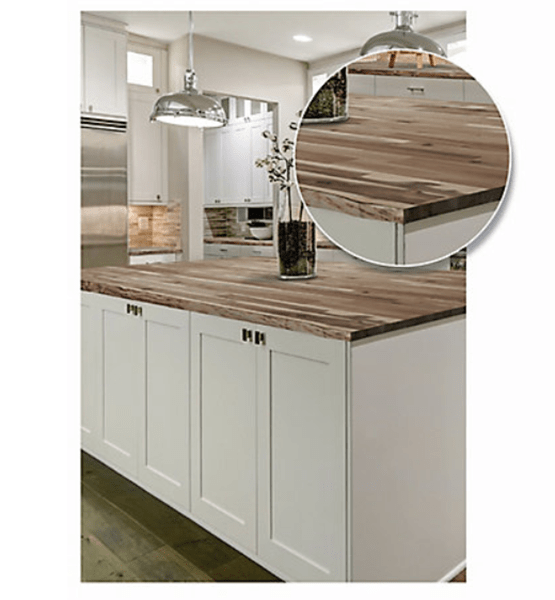Kitchen style and atmosphere are significantly influenced by the countertops. We can assist you whether you’re performing a major renovation or simply updating cabinets and countertops. Acacia butcher block is a choice to think about because of our attractive countertop and cabinet selections, as well as our expert installation service.

Are you having trouble selecting acacia butcher block?
Uncertain of where to begin when choosing acacia butcher block? It’s challenging to decide with so many possibilities available. Check out our Countertop Buying Guide before you start your search.
Here, we describe the variations between common cabinet alternatives, including butcher block countertops, laminate countertops, and more.
Wood countertops, commonly referred to as butcher block island tops, instantly give any kitchen a rustic character. They require little upkeep because nicks and scratches may be easily removed with sanding.
Whether you desire black countertops, marble, white matte, or something else, they are available in a variety of hues and patterns to match any kitchen.
Custom-made butcher block countertops made of acacia are available. There are numerous different hardwood species available for butcher block countertops. Butcher block countertops with edge grain can also be created from a variety of wood species.
Additionally, staining is an option, with the choice between a standard stain color and bespoke stain matching. There is a wide range of edge details available for wood and butcher block countertops made of acacia, from a beautiful classic and ogee edge to a somewhat eased edge.

If you enjoy the warmth and natural beauty of wood, butcher block countertops and wood countertops are excellent choices for kitchens or any other space. Wide edge grain strips are used to create edge grain butcher block surfaces.
Acacia butcher block countertops have full-length solid wood strips, which improves their appearance and increases their longevity compared to blended butcher blocks supplied by other butcher block producers, where short strips are linked together.
Island tops, tabletops, and bar tops are all excellent uses for butcher block counters. Custom stove cutouts, sink cutouts, and other custom cuts are now options available.
Acacia wood has a distinctive wood grain diversity that adds elegance and charm. Since these countertops are unfinished, you have more freedom to choose a finish that complements any design sensibility.
Butcher block countertops are durable, simple to maintain, and enhance the appearance of any space. With gorgeous butcher block counters, you can give your kitchen, home office, mudroom, or workshop a distinctive look. For safety and aesthetic appeal, our butcher block counters can be condition, stained, and sealed.
Countertop’s main material is acacia wood
We should educate ourselves about acacia wood first. A hardwood that can withstand significant weather variations is acacia wood. From tropical to temperate locations, it is frequently used in both interior and external furniture. Because of this, even when exported to Europe, our native acacia wood countertop maintains its outstanding quality.
Cutting boards, dining tables, luxury countertop and island designs, and other items are being made from the natural wood acacia. But it’s more than just a passing fad.
Acacia, often known as Asian walnut, has long been revered for its beauty and durability. Live edge fans continue to order premium cutting boards, countertop components, and island fittings for their opulent interior designs because of the natural edge that acacia wood offers.
Not to mention that it’s a sustainable wood that just needs occasional upkeep to maintain its stunning appearance. Your Asian walnut wood will continue to look as stunning as the day you bought it with a little bit of oil here and there.
Acacia trees can be utilized to build or produce furniture after 7-8 years of growth. Its timber is heavy and strong enough to endure friction and outside forces.
Acacia wood typically has reddish-brown and dark patterns in the center. It is light brown or yellowish when cut into pieces. The wood has straight or occasionally wavy grain.

Acacia butcher block type
Acacia butcher blocks are produced from acacia wood. Acacia butcher block countertops are divided into Finger Joint, Solid, and Herringbone categories based on the characteristics of the surfaces and the way the wood staves are joined.
The acacia butcher block process of production
The production of acacia wood countertops involves several processes, each of which is strictly supervised and adheres to a certain standard. Acacia wood countertops that are uniform in terms of regulated quality and appearance are what we strive to offer to our customers.
Step 1: Acacia wood is first sawn and chopped into sticks of standardized sizes.
Step 2: To increase resistance against insects and bugs, acacia wood sticks are soaked in a specific chemical. They will next undergo kiln drying to get the necessary moisture level.
Step 3: Determine the acacia wood sticks’ color and quality ratings.
Step 4: Using an appropriate adhesive, fasten wood bars into the wood butcher block panel.
Step 5: Sanding, treatments, and inspection evaluation of acacia wood boards are done to meet requirements in Asia or Europe.
Cons and advantages of acacia butcher block
* Cons of acacia butcher block- The surface may be prone to crack or distort when exposed to severe temperatures for an extended period of time.
– After some time, the color of an acacia wood countertop may change. To keep the countertop in good condition, the Mineral oil or Wax oil must be covered.
* Advantages of acacia wood countertops include their durability.
Since acacia wood is a hardwood, it has a good resistance to impact. One of the hardest types of wood hardness measurement is thought to exist. It is more durable than bamboo, acer, or other common types of wood.
Acacia wood also retains water well, making it less likely to warp or mold in high-moisture environments like kitchens or laundry rooms.
– Inherent antimicrobial properties
Acacia countertops are safe enough to be used as trays or kitchen appliances because of this property.
– Both aesthetics and comfort
The beautiful texture and color of the acacia wood countertop provide the kitchen and living area a cozy, lively ambiance. When used, it fulfills the requirements and keeps you feeling comfortable. Another crucial aspect is that acacia butcher block countertops have a long lifespan.
- Flat surface
Due to the wood’s natural smoothness and other textures, even the rough surface looks fantastic. This makes it easier for the surface to hold gloss or paint. As a result, cleaning the acacia wood countertop is a simple and enjoyable chore. Three categories of acacia wood countertops are available:
Three popular varieties, based on quality standards, are as follows: A, C, and B
Environmentally responsible: Acacia trees are raised for industrial use (plantation timber). Acacia wood is sourced from sustainably managed, economically successful, socially helpful, and environmentally conscientious forests.
Think about the color scheme of your kitchen.
Making the decision to use acacia butcher block countertops is difficult. So, one of the first things to think about is the style and atmosphere of your current kitchen. Which material will suit you the best will depend on the design.
Despite having a distinctive texture, acacia can seamlessly integrate into your kitchen’s decor.
Acacia wood often ranges from medium to dark in color, with light margins. Given that it features both light and dark colors, it is a simple match for your existing color scheme.

Acacia butcher block maintenance
Since acacia wood is resistant to moisture and water damage, it just needs occasional maintenance. Acacia butcher block counters will still require the occasional washing with soap and water or a solution designed to shield the surface from stains and spills.
Due to its susceptibility to humidity, birchwood may need a little bit more maintenance than acacia, but it is still simple to keep. Leaving water on the acacia butcher block countertop for an extended period of time should be avoided.
Your kitchen’s acacia butcher block countertop will benefit from being oiled once a month or so with mineral or coconut oil. But how frequently it is used and cleaned will determine everything.
Use vinegar or soap and water to wash the acacia butcher block countertop after each use if you plan to use it as a cutting board. Use separate cutting boards rather than chopping directly on your kitchen countertop to preserve it.
Sand down any nicks or scratches and fill them in at least once a year to protect the original wood. If taken care of properly, these countertops can endure a very long period.
Conclusion
Because of its cost effectiveness, sustainability, and other amazing qualities, acacia butcher block is a good option if you’re seeking for eco-friendly and beautiful natural materials for your living area.
Khoa Pham
